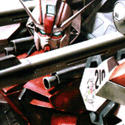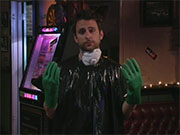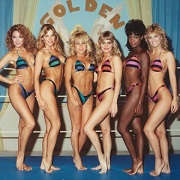|
vintagepurple posted:What was the life of an artilleryman like during the world wars, expecially the first? It seems like almost all the accounts focus on front-line infantry or on flashy jobs like pilot. Were they artillery full-time or did they get sent on patrols, second-rate infantry missions, etc. like modern artillery units often do? Obviously the first caveat is "it depends" based largely on who you were fighting for and where (ie, life as an Austro-Hungarian artilleryman was maybe the worst single spot to be in the entire war). Second caveat is "it depends" based on what sort of artillery you were operating. I'll describe how things were on the western front as that's what we usually think of. For the guys who were posted to regimental field guns life was basically like that of an infantryman except you had to haul around a light artillery piece (largely by hand) that also happened to be a particularly tempting target for the other side. This sucked uniquely because you'd be in an area to be targeted by small arms, enemy field guns, and enemy artillery all at the same time, plus you were the primary target to suppress at the start of just about any division-sized action. Details are kind of sketchy on this but I've heard claimed that these guys had the highest casualty rate of any other job in the war with the exception of fighter pilots. Life on the bigger field artillery pieces was pretty different. These were usually divisional/corps assets and they'd be a few kms behind the front line trenches. Life involved a whole lot of digging, carrying heavy shells everywhere, replacing barrels and breeches almost constantly, muscling enormous guns through seas of mud (or trying to get horses to do it), but at least you weren't under direct fire most of the time. That being said, these units were the highest priority targets for both counterfire and suppression missions so if you didn't have proper cover things could get pretty unpleasant. Casualty rates for these guys were about half that of the infantry. Whether it sucked more than life for the infantry is debatable...it was unarguably more physically demanding but you were generally safer, so it kind of depends where you priorities were. For guys on the heavy artillery pieces and the massive siege guns life was quite a bit better. They were usually located close to rail lines and roads and so were somewhat out of the sea of mud, plus the pieces and ammunition were so large that you literally couldn't just muscle everything everywhere. While nowadays these types of targets are #1 super top priorities, back then you were largely ignored as a target as no systems could effectively reach that far behind the lines. The other nice thing, particularly if you were British, is that these units were consistently the top priority of the army and thus generally got the best of everything. All sides tended to locate the smart guys at the fire direction centers for their heavy guns, as these were the weapons that did most of the counterfire missions and this was a relatively complicated task.
|
|
|
|

|
| # ? Jun 5, 2024 23:45 |
|
SeanBeansShako posted:Oh great, now I want to know all the 2nd World War armies slang now we've been given than awesome German lesson. Second that. I want to hear more russian army slang.
|
|
|
|
JaucheCharly posted:Second that. I want to hear more russian army slang. Here are some I remember: Kozya Nozhka (goat's leg): self-made cigarette. Not really army specific, I think. Suchka (bitch): AKS-74U Ded (grandpa): a soldier nearing the end of his conscription term. Dukh (spirit): a soldier at the start of his conscription term. Ogurets (cucumber): a soldier that is halfway done his conscription term. Zapakh (smell): a soldier that hasn't sworn his oath yet. Komod (dresser): squad leader Lifchik (bra): magazine pouch Pomidor (tomato): internal forces soldier Hobot (elephant's trunk): gas mask. Similarly, soldier wearing gas masks are called elephants.
|
|
|
|
Oh, "Elephants" was also GDR slang for people with Gas masks. As far as "how to translate what Soviet ground soldiers are saying in War movies to what they have actually said" that is actually very easy. Replace anything that sounds like party jargon with different kinds of expletives.
|
|
|
|
bewbies posted:Obviously the first caveat is "it depends" based largely on who you were fighting for and where (ie, life as an Austro-Hungarian artilleryman was maybe the worst single spot to be in the entire war). Second caveat is "it depends" based on what sort of artillery you were operating. I'll describe how things were on the western front as that's what we usually think of. Didn't some of those larger siege pieces basically need to have a foundation poured (of cement) before firing and then when done they needed to be blasted out of the cement emplacement for transport? I recall a documentary pointing this out during WWI, I think specifically some German guns used to reduce fortresses in Belgium.
|
|
|
|
What are finnish phallic references btw. I need this. Research.
|
|
|
|
Yes, some guns like this one had a 115 step long foundation building process. With more modern recoil mechanisms, you can build bigger guns that are more mobile. The Soviets had a 280 mm mortar, even. My favourite fact about it is that it took 3 minutes longer to load if you factor in the crew running to a safe distance before firing.
|
|
|
|
Frostwerks posted:What are finnish phallic references btw. I need this. Research. Egg, screwdriver, paddle, tool, Jorma (Finnish version of Jeremiah), stick etc. Eg. military command "Meisselit turpeeseen!" = lit. "Screwdrivers into turf!" meaning to dive into ground so hard that your penis would figuratively sink into ground. (At least in my time it was only meant figuratively...)
|
|
|
|
FAUXTON posted:Didn't some of those larger siege pieces basically need to have a foundation poured (of cement) before firing and then when done they needed to be blasted out of the cement emplacement for transport? I recall a documentary pointing this out during WWI, I think specifically some German guns used to reduce fortresses in Belgium. The Germans had several Bettungsgeschütz-type (roughly "bedding gun") heavy guns in their arsenal during WWI. Guns like the 42cm Gamma Gerät had to be placed on a concrete platform to absorb recoil. Most heavy artillery pieces required gunners to prepare a firing platform. Germany's infamous 42cm Big Bertha hwoizter had to be emplaced on steel matting. To let curvedBertha traverse, the howitzer's trail rested on a curved steel frame stuck into the ground with a spade. This system let gunners deploy Bertha more quickly than the Gamma Gerät. Bertha was also more mobile than its predecessor, since it was (somewhat) lighter and had pedrail wheels. British heavy guns required a similar degree of preparation. The BL 9.2-inch howitzer sat on top of a steel girder "holdfast," part of which gunners hand to sink into the ground. This holdfast was kept in place by a boxed filled with 9-11 tons of dirt, a box the poor gunners presumably had to fill by hand. Mounting the guns on soft ground demanded further labor, forcing the gunners reinforce the holdfast with extra beams.  The BL 8-inch howitzer demanded a similar amount of labor. Gunners had to dig a shallow hole, emplace a triangular wooden frame and then bury the frame again. Then, they had to place steel pads for the wheels and a circular frame for the gun trail, allowing the gun to traverse. Then they could position their multi-ton howitzer in position.  You can read more about WWII heavy artillery in this 1920 US Army Ordnance Manual
|
|
|
|
Watching those guns being loaded and fired must have been almost strangely hypnotic. And of course, loud as gently caress.
|
|
|
|
|
SeanBeansShako posted:And of course, loud as gently caress. It gets better over time, though.
|
|
|
|
FAUXTON posted:It gets better over time, though. Only because you're getting deafer.
|
|
|
|
You can only rupture your eardreams once!
|
|
|
|
|
SeanBeansShako posted:You can only rupture your eardreams once!
|
|
|
|
Well, you can only break them once around heavy World War era railguns at least then. Those things will never grow back.
|
|
|
|
|
If the thread didn't figure this out during my posts about early modern medicine, I actually know nothing about medicine.
|
|
|
|
HEY GAL posted:If the thread didn't figure this out during my posts about early modern medicine, I actually know nothing about medicine. It's OK, neither did the people you study.
|
|
|
|
Ensign Expendable posted:Yes, some guns like this one had a 115 step long foundation building process. With more modern recoil mechanisms, you can build bigger guns that are more mobile. The Soviets had a 280 mm mortar, even. My favourite fact about it is that it took 3 minutes longer to load if you factor in the crew running to a safe distance before firing. Don't forget the 420mm Oka.  http://en.wikipedia.org/wiki/2B1_Oka
|
|
|
|
my dad posted:It's OK, neither did the people you study. A lot of what we know about anatomy comes from this period, I think. A bunch of body parts are named after the early modern Italians who first described them scientifically.
|
|
|
|
Nenonen posted:Egg, screwdriver, paddle, tool, Jorma (Finnish version of Jeremiah), stick etc. Because you can feel the other guy's penis pressing against your body.
|
|
|
|
Fangz posted:Don't forget the 420mm Oka. Designed by a guy desperately overcompensating surely. I mean, that's what I would build.
|
|
|
|
Frostwerks posted:Designed by a guy desperately overcompensating surely. I mean, that's what I would build. "Its actually a 3:1 scale model"
|
|
|
|
Oh man I haven't checked it in a while. Does anyone aside from Canadians even remember this? 
|
|
|
|
Eej posted:Oh man I haven't checked it in a while. Does anyone aside from Canadians even remember this? That was actually a considerable portion of US recruiting effort for the Mexican-American war. Buncha Irishmen joined up to fight Brits in Canada. Things went south from there.
|
|
|
|
xthetenth posted:That was actually a considerable portion of US recruiting effort for the Mexican-American war. Buncha Irishmen joined up to fight Brits in Canada. Things went south from there. Literally and metaphorically
|
|
|
Bacarruda posted:The Germans had several Bettungsgeschütz-type (roughly "bedding gun") heavy guns in their arsenal during WWI. Guns like the 42cm Gamma Gerät had to be placed on a concrete platform to absorb recoil. Am I wrong in thinking that pieces like this were just enormous wank-wank boondoggles built more for nationalistic pride and hitler-style bigger=better reasoning than actual usefulness? Seems like if you had a hundred more normal sized guns instead, you could do a lot more damage than firing one gigantic shell of questionable accuracy every half hour.
|
|
|
|
|
Bacarruda posted:Only because you're getting deafer. 
|
|
|
|
HEY GAL posted:That's not true, my mother had one of hers rupture due to measles, which can cause ear infections, and since she can hear fine I think it must have grown back. They do in fact recover, although with scar tissue (which can / eventually will gently caress your hearing).
|
|
|
|
Slavvy posted:Am I wrong in thinking that pieces like this were just enormous wank-wank boondoggles built more for nationalistic pride and hitler-style bigger=better reasoning than actual usefulness? Seems like if you had a hundred more normal sized guns instead, you could do a lot more damage than firing one gigantic shell of questionable accuracy every half hour. SOmetimes it just takes that much ordinance to dig a particularly deeply dug in enemy out. Remember, these aren't field guns that are intended to rapidly advance with armies, they're siege weapons. Artillery shells also get much more effective with caliber increase. Smaller shells need proportionally more of the shell to be casing just to withstand the forces of firing. The really huge poo poo is where you can put really gently caress off big explosions on target. That issue is actually one of (although far from the only) reasons heavy bombardment shifted away from artillery and over to aircraft - bombs are prone to much less stress when deploying them, so you can pack even more HE into a relatively insanely thin casing.
|
|
|
|
Slavvy posted:Am I wrong in thinking that pieces like this were just enormous wank-wank boondoggles built more for nationalistic pride and hitler-style bigger=better reasoning than actual usefulness? Seems like if you had a hundred more normal sized guns instead, you could do a lot more damage than firing one gigantic shell of questionable accuracy every half hour. Not really, no. While in general it's true that lots of medium pieces is better than one or two super heavy ones, the super heavy ones aren't necessarily insane, they may just have been designed for a real purpose that no longer exists when it enters service. And sometimes you really just need the huge shell, not a lot of small ones. Bunker busters are the primary example of this. The enemy possesses troublesome bunkers that your guns couldn't take out. What do you do? Build bigger guns, of course! But it takes a very long time to build, test and crew guns that can do that, and during that time your new super gun may have become useless because there no longer are super fortresses to blast away at. For example the Soviet KV-2 with its 152mm gun was an effective weapon system if it had been introduced against bunker lines like in Finland 1939 but it turned out to be a lemon in the mobile operations of 1941 and was dropped out of production. On the other hand, bombs like Tall Boy or Grand Slam could be developed and deployed much more flexibly because all you needed was a plane capable of carrying them. As long as you can hit the target (say a U-boat pen), that Grand Slam is going to be a lot more effective than an equal weight of 250kg bombs.
|
|
|
|
Magni posted:Spandaus are MG-42s and Ofenrohr (Stovepipe) was the Landser nickname for the Panzerschreck.
|
|
|
|
100 Years Ago Having looked at the plans for First Artois, it's now time to check out First Champagne. And it's quite interesting, too; some of the orders being given are at least six months ahead of their time, particularly when considered from a British perspective. This is also the first appearance I've seen of the soon-common tactic of ordering a pause in the middle of a heavy barrage, so that the enemy comes out of their dugouts to meet the apparent attack and then gets blowed up real good when the guns open fire again. The paper also has another excellent story of fraternisation, including mention of a common phenomenon; British soldiers meeting Germans who spoke excellent English and it turning out that before the war they'd been working in a pub or as a pork butcher at some well-known establishment.
|
|
|
|
So guess who just learned about the Dreyfus affair? What the gently caress? No wonder the French Army mutineed in the First World War. That whole thing was a circus. A circus dedicated to ruining a honest mans life.
|
|
|
|
|
bewbies posted:Obviously the first caveat is "it depends" based largely on who you were fighting for and where (ie, life as an Austro-Hungarian artilleryman was maybe the worst single spot to be in the entire war). I feel like I missed a post here. What was the issue with being a Austro-Hungarian artilleryman?
|
|
|
|
SeanBeansShako posted:So guess who just learned about the Dreyfus affair? "If, in the 1920s, one European told another one that a major power was on the verge of not only developing harsh legislation against Jews but also seriously attempting to kill them all, the response would have been 'Wow, I know. The French are so anti-Semitic they'd come up with anything.'"
|
|
|
|
Trin Tragula posted:100 Years Ago Came across these which relate to the home front. A couple weeks more than 100 years ago, but relevant. Sure, there's a war on, but it's not like it's football. Nov. 24: FOOTBALL, NOT WAR, ATTRACTS ENGLISH; London Papers Disgusted by Crowds of Young Men Who Attend Games. APPEALS TO THEM IN VAIN Bands of Recruiting Officers Meet with Stolid Refusal ;- More Talk of Conscription. Nov. 24: The "Football Cancer." Nov. 26: WOULD FORBID FOOTBALL.; Member of House of Commons to Ask Asquith for Legislation. Nov. 27: NOT TO FORBID FOOTBALL.; Asquith Says the Situation Does Not Yet Demand Legislation. Nov. 28: TO CURTAIL FOOTBALL NEWS; London Publishers Agree on Measure to Aid Recruiting. Nov. 29: WON'T REPORT FOOTBALL.; Decision of London Observer ; Denounces Leagues' Heedlessness. Dec. 1: AGITATION DENOUNCED BY FOOTBALL CLUBS; Say Liberty of Press Is Abused ;- Will Stop Games if Theatres Close. Dec. 4: NO BIG FOOTBALL MATCHES.; "International" Games to be Called Off, but Others to Continue. Dec. 6: FOOTBALL PLAYERS ENLIST.; One English Club Offers to Pay Half Wages While They Serve.
|
|
|
Oh god that joke. Comstar posted:I feel like I missed a post here. What was the issue with being a Austro-Hungarian artilleryman? You are operating broken down artillery obsolete by 1890's standards in the frigging alps against the Italians. Comedy edit, your officers still don't understand your nations language too!
|
|
|
|
|
Antti posted:I've never been in the FDF myself but I've always been fascinated by Finnish military jargon. Some military jargon is so ubiquitous thanks to conscription that it's seeped into colloquial speech. "Molotov cocktail" is by far the most famous coinage by Finnish soldiers (parodying the "Molotov's bread baskets" that the Soviet bombers were claimed to be dropping). Speaking of which, I've been meaning to ask. How did the molotov cocktail become a popularized term in the United States whereas in the UK it's petrol bomb? Did we have some solidarity thing with the Finns?
|
|
|
|
Here's some more Finnish army slang off the top of my head: Gona: a soldier nearing the end of his conscription term. Presumably derived from "goner". Napalmi (napalm): army style mashed potatoes. Juustokiekko (wheel of cheese): anti-tank mine. The ones used for training are yellow. Noukkarit: army issue winter mittens. Derived from "no can do" because it's impossible to do anything when wearing them. Sorsa (mallard): M-98 field cap. It's a really lovely hat that kind of looks like a duck. Nallepuku (Teddy bear suit): woollen mid layer suit. Norsunvittu (elephant oval office): fur cap. Kenttäpillu (field oval office): tearing the crotch of your M/62 BDUs. Leirikyrpä (camping cock): a wooden penis one whittles in the woods.
|
|
|
|

|
| # ? Jun 5, 2024 23:45 |
|
SeanBeansShako posted:You are operating broken down artillery obsolete by 1890's standards in the frigging alps against the Italians. Well, but at least you get to mostly sit on top of the mountain. For my money, the most heartbreaking stories of the entire war come from the Isonzo, when the slaughter gets so ridiculous that the Austro-Hungarians just stop firing at the last remnants of units that can't possibly get anywhere near them, and start yelling "Go away, we've killed enough of you, just leave."
|
|
|


































